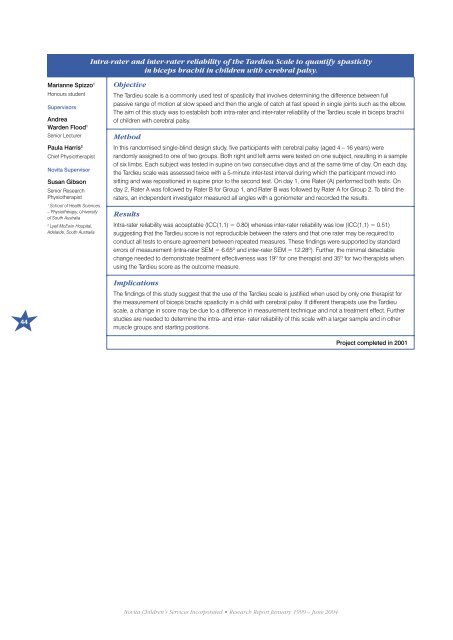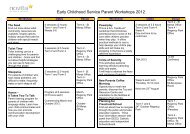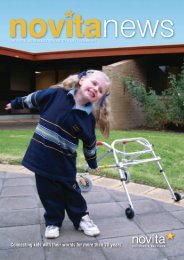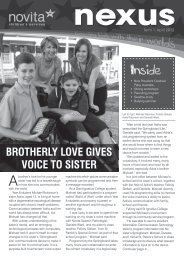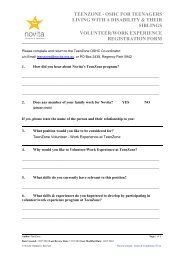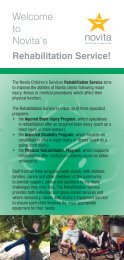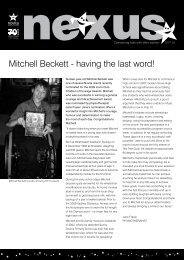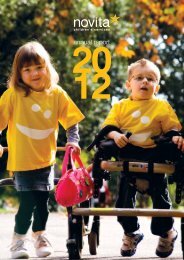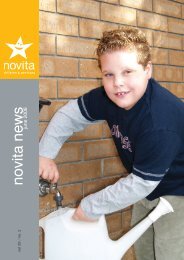Novita Research Report January 1999 - Novita Children's Services
Novita Research Report January 1999 - Novita Children's Services
Novita Research Report January 1999 - Novita Children's Services
You also want an ePaper? Increase the reach of your titles
YUMPU automatically turns print PDFs into web optimized ePapers that Google loves.
Intra-rater and inter-rater reliability of the Tardieu Scale to quantify spasticity<br />
in biceps brachii in children with cerebral palsy.<br />
Marianne Spizzo 1<br />
Honours student<br />
Supervisors<br />
Andrea<br />
Warden Flood 1<br />
Senior Lecturer<br />
Paula Harris 2<br />
Chief Physiotherapist<br />
<strong>Novita</strong> Supervisor<br />
Susan Gibson<br />
Senior <strong>Research</strong><br />
Physiotherapist<br />
1<br />
School of Health Sciences<br />
– Physiotherapy, University<br />
of South Australia<br />
2<br />
Lyell McEwin Hospital,<br />
Adelaide, South Australia<br />
Objective<br />
The Tardieu scale is a commonly used test of spasticity that involves determining the difference between full<br />
passive range of motion at slow speed and then the angle of catch at fast speed in single joints such as the elbow.<br />
The aim of this study was to establish both intra-rater and inter-rater reliability of the Tardieu scale in biceps brachii<br />
of children with cerebral palsy.<br />
Method<br />
In this randomised single-blind design study, five participants with cerebral palsy (aged 4 – 16 years) were<br />
randomly assigned to one of two groups. Both right and left arms were tested on one subject, resulting in a sample<br />
of six limbs. Each subject was tested in supine on two consecutive days and at the same time of day. On each day,<br />
the Tardieu scale was assessed twice with a 5-minute inter-test interval during which the participant moved into<br />
sitting and was repositioned in supine prior to the second test. On day 1, one Rater (A) performed both tests. On<br />
day 2, Rater A was followed by Rater B for Group 1, and Rater B was followed by Rater A for Group 2. To blind the<br />
raters, an independent investigator measured all angles with a goniometer and recorded the results.<br />
Results<br />
Intra-rater reliability was acceptable (ICC(1,1) = 0.80) whereas inter-rater reliability was low (ICC(1,1) = 0.51)<br />
suggesting that the Tardieu score is not reproducible between the raters and that one rater may be required to<br />
conduct all tests to ensure agreement between repeated measures. These findings were supported by standard<br />
errors of measurement (intra-rater SEM = 6.65º and inter-rater SEM = 12.28º). Further, the minimal detectable<br />
change needed to demonstrate treatment effectiveness was 19º for one therapist and 35º for two therapists when<br />
using the Tardieu score as the outcome measure.<br />
44<br />
Implications<br />
The findings of this study suggest that the use of the Tardieu scale is justified when used by only one therapist for<br />
the measurement of biceps brachii spasticity in a child with cerebral palsy. If different therapists use the Tardieu<br />
scale, a change in score may be due to a difference in measurement technique and not a treatment effect. Further<br />
studies are needed to determine the intra- and inter- rater reliability of this scale with a larger sample and in other<br />
muscle groups and starting positions.<br />
Project completed in 2001<br />
<strong>Novita</strong> Children’s <strong>Services</strong> Incorporated • <strong>Research</strong> <strong>Report</strong> <strong>January</strong> <strong>1999</strong> – June 2004


